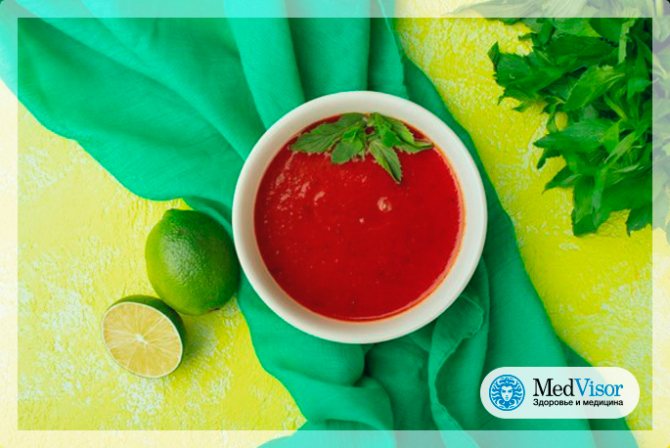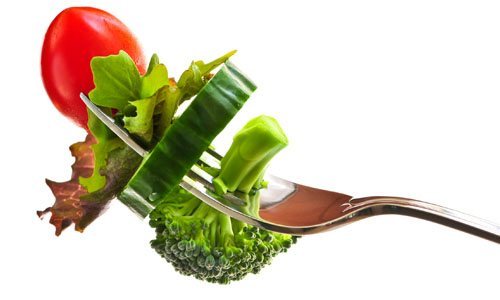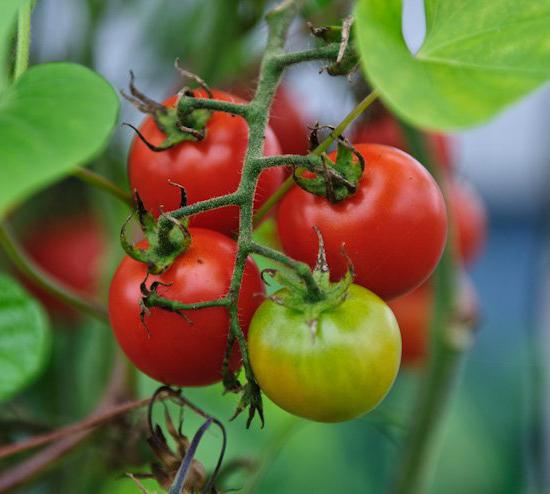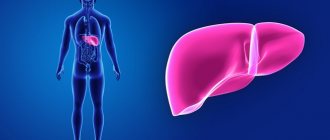Tomatoes can contribute to the fight against excess weight - a low-calorie product, rich in vitamins and extremely beneficial for health. Calorie content of tomato per 100 grams is quite low, does not exceed 20 kcal. A certain amount of calories is spent on its processing, which reduces the already small energy value of the tasty vegetable. So you won’t be able to gain weight by eating tomatoes.
The homeland of tomatoes is Central America, 2.5 thousand years ago the Incas and Aztecs cultivated the sacred fruit - “tomatl”, which means “large berry”. They were brought under this name in the 16th century. to Europe, where tomatoes were initially considered poisonous and were used only to decorate gardens and window sills. But already in the 18th century. Cheerful Italians ate the “golden apples” – “pomi d'oro” – with appetite, seasoning them with butter and pepper. From Italy they arrived on the table of Catherine II. The taste of bright vegetables charmed the empress, and with her help, “golden apples” began to be grown in Russia for consumption.
The benefits of tomatoes
Ripe tomatoes are a pharmacy containing vitamins, microelements, antioxidants, which we often lack. Such as:
- Tomatoes contain the most carotene - 400-500 grams of red fruits cover the daily requirement of a substance that is beneficial for the eyes.
- Ascorbic acid and B vitamins promote normal metabolism, increase immunity, and improve skin condition.
- Pink varieties are richest in vitamin C; they also contain selenium, which increases immunity and mental activity.
- Tomatoes contain a lot of potassium and magnesium, which makes them a valuable product for heart patients; potassium helps remove excess fluid and reduces swelling.
- Tomatoes are useful to eat to prevent anemia, because they contain iron and copper, without which hemoglobin synthesis is impossible.
- The seeds of ripe vegetables with the flavonoids surrounding them reduce blood viscosity and prevent the formation of blood clots.
- “Golden apples” contain an abundance of a valuable dye - lycopene - the strongest natural antioxidant. It not only has a beneficial effect on the functioning of the heart, but also prevents the formation of cancer cells. The yellow varieties contain especially a lot of lycopene.
- Tomatoes are the berries of joy - their consumption increases the level of serotonin in the blood, which improves mood and helps overcome depression.
Tomatoes are a real balm for the digestive tract. The watery structure of the vegetable facilitates its digestion in the stomach; the skin promotes peristalsis of the intestinal walls, keeping it “toned.” Tomato diets are popular among those losing weight, because due to their chromium content, these vegetables reduce appetite and cause a long-term feeling of fullness.
Video
Benefits and harms
All these substances that the body needs so much make tomatoes extremely useful and important for humans. What are the beneficial properties of tomatoes you need to know:
- Improves memory, improves mood, gives strength;
- Normalizes the condition of hypertension, low hemoglobin, high cholesterol, gastritis;
- Accelerates metabolic processes, improves the functioning of the digestive system;
- Positively affects the health of the genital organs, improves the quality of sexual life;
- Allows you to maintain visual acuity;
- Strengthens the cardiovascular system;
- Removes toxins and all kinds of waste from the body.
A large amount of vitamins and minerals does not guarantee the exceptional usefulness of the product. Any type of tomato can cause allergies, which is important to consider, especially if you are giving this vegetable to your child for the first time.
Does a tomato have negative calories?
As for the calorie content of a tomato, it should immediately be noted that it is not negative.
Please note: The only food proven to be zero calorie is pure water. It does not contain proteins, fats or carbohydrates, but the body will have to spend several calories to cool or heat the water to body temperature - this will result in a negative calorie effect
Any food product (except water) consists of proteins, fats, and carbohydrates. Their absorption requires 10-15% of the calories they supply to the body.
The composition of BJU in a fresh tomato looks like this:
- Proteins – 0.6 g/100g;
- Fats – 0.2 g/100 g;
- Carbohydrates – 4.2 g/100 g.
You need to add fiber (0.8 g/100 g) and water (93.5 g/100 g) to the tomato BJU - these nutrients do not contain calories. A fresh tomato has a calorie content of about 20 kcal per 100 grams, 3-4 kcal will be spent on its absorption, a small remainder will replenish the body’s calorie reserves. The energy value of tomato is not negative, but low enough that it can be used in weight loss diets.
Micro- and macroelements in Tomato
Tomato contains the following elements: Mono- and disaccharides, Ash, Starch, Water, Organic acids, Dietary fiber, Sodium, Potassium, Phosphorus, Magnesium, Calcium, Sulfur, Copper, Boron, Iodine, Manganese, Chromium, Fluorine, Molybdenum, Cobalt, Nickel, Rubidium, Selenium, Zinc, Iron, Chlorine.
| Mono- and disaccharides, g. | 3,5 |
| Zola, Mr. | 0,7 |
| Starch, Mr. | 0,3 |
| Water, city | 93,5 |
| Organic acids, g. | 0,5 |
| Dietary fiber, g. | 0,8 |
| Sodium, mg | 40 |
| Potassium, mg | 290 |
| Phosphorus, mg | 26 |
| Magnesium, mg | 20 |
| Calcium, mg | 14 |
| Sulfur, mg | 12 |
| Copper, µg | 110 |
| Boron, µg | 115 |
| Iodine, mcg | 2 |
| Manganese, mg | 0,14 |
| Chromium, µg | 5 |
| Fluorine, mcg | 20 |
| Molybdenum, mcg | 7 |
| Cobalt, µg | 6 |
| Nickel, µg | 13 |
| Rubidium, mcg | 153 |
| Selenium, mcg | 0,4 |
| Zinc, mg | 0,2 |
| Iron, mg | 0,9 |
| Chlorine, mg | 57 |
Dependence of calorie content on cooking method
When figuring out how many calories are in a tomato, you need to consider the method of its preparation.
Table: calorie content of tomatoes for various treatments
| Processing method/grade | Calorie content kcal/100 g |
| Salty | 13 |
| Pickled | 15 |
| Cherry | 15 |
| Pickled | 16 |
| Tomato juice | 18 |
| Fresh | 20 |
| Stewed | 20 |
| Baked | 27 |
| Dried | 258 |
- As can be seen from the table, salted vegetables have the lowest calorie content, while they retain all the vitamin composition and microelements of fresh fruits.
- After cooking, pickled tomatoes lose the lion's share of vitamins, but remain a low-calorie product that is useful for weight loss. A high content of lycopene and essential microelements (potassium, manganese, iron) remains at the bottom.
- The miniature cherry variety quickly gained popularity: small tomatoes are much sweeter and tastier than their large counterparts and can perfectly decorate any dish.
- The value of tomato juice is that it contains more lycopene than fresh vegetables. 1 piece of large fruit weighing 100 g contains 1.5 mg of lycopene, while 100 ml of tomato juice contains 7-8 mg. Two glasses of juice a day will cover the body's daily need for this powerful natural antioxidant.
- Properly prepared stewed and baked tomatoes contain more calories, but they are superior in lycopene content to fresh fruits. 100 g of dish contains less water, but a higher percentage of lycopene and microelements.
- Some meat dishes have fewer calories than canned sun-dried tomatoes, generously seasoned with olive oil. In homemade preparations, they are cooked in dryers for 5 hours at t° = 80° with a lot of salt. Deprived of moisture, sun-dried tomatoes have the maximum content of vitamins and all other beneficial nutrients and are a concentrated medicinal product.
How many calories are in a tomato or how to properly go on a tomato diet
It turns out that even the same vegetable can provide different amounts of energy, depending on when it was picked, where it was stored, and under what conditions it grew. In order for the diet to be as effective as possible, you need to know how many calories are in the tomato that you buy at the market, how to choose it correctly, and what product is not advisable to eat.
A fresh greenhouse tomato has an average of 17 kcal per 100 grams of pulp. But exactly the same product, just taken from the garden, will already contain 23 kcal. This difference is due to the fact that in open ground there are more useful minerals, organic matter, as well as light, due to which more chlorophyll accumulates in the plant during photosynthesis. But remember that any chemicals that are used to treat plants in greenhouses can be dangerous not only for your figure, but even for your health. Do not buy a product if you are not sure of its environmental friendliness and do not have a nitrate tester on hand. It is better to give preference to those that were grown in open ground.
If calorie content is very important to you, it is best to boil the tomato - then the organic substances are washed out of it, and there will not be more than 13 kcal in 100 grams of the product. But remember that heat treatment kills 80% of vitamins, so its relevance is extremely doubtful. It will be useful for people whose goal is only weight loss and are not interested in improving the health of the whole body in a comprehensive manner.
A green tomato will be much “easier” for the body; it contains practically no calories, since most of them get there during the ripening process. 100 grams of green tomato will contain no more than 6 kcal. But keep in mind that you should not overdo it with the consumption of such a product, since the green vegetable contains many organic acids, including hydrocyanic acid. It can poison the body if there is a large accumulation of it in the gastrointestinal tract. Follow the norm, do not consume more than 300 grams per day.
Thus, we can conclude that by eating a tomato in your diet, your body will receive from 6 to 23 kcal, but will spend about 38 kcal on digesting this mass of food. The more you eat, the more weight you will lose. But remember that a diet of one product is dangerous for the body, no matter what you eat. You must supply him with the required portion of microelements every day. Just reduce your portions by replacing them with tomatoes and you will lose weight very quickly!
Tomatoes for weight loss
Despite their low calorie content, tomatoes are not a product that can be regularly used in mono-diets. By eating only vegetables with a minimum content of dietary fatty acids, you can lead your body to exhaustion, disrupt your metabolism, and ruin your health. In addition, tomatoes increase the acidity of gastric juice, and such a mono-diet often ends in gastritis. Oxalic acid, which is rich in bright red vegetables, accelerates the formation of oxalate stones in the kidneys. Tomatoes work effectively for weight loss if you replace one high-calorie meal with them in your daily diet. Instead of an abundance of calories, the body will receive an excellent vitamin supplement that stimulates the gastrointestinal tract, maintaining a feeling of fullness for a long time.
Video
Weight loss
Eating right is the best way to stay fit. With the help of tomatoes you can make your diet even more correct and healthy. Tomatoes are an excellent substitute for dinner, and can also be used in special diets where other foods are prohibited.
Nutritionists recommend drinking tomato juice more often, because... it satisfies hunger and lifts your spirits. They also advise using a three-day tomato diet, which allows you to say goodbye to 5 kg at once.
The main reason why tomatoes help you lose extra pounds is its red color. The color is determined by lycopene, which accelerates the breakdown of any fats and improves the general condition of the gastrointestinal tract, which promotes weight loss. The second reason is the feeling of fullness that appears immediately after eating the vegetable. And the third reason is low calorie content, and not a single carbohydrate is harmful to the figure.
Top 10 vegetables for weight loss
Vegetables for weight loss are not only food with a low amount of calories, but also a source of vitamins, valuable substances necessary for promoting health.
Along with tomatoes, it is useful to involve in the fight against excess weight:
- Eggplants – 4 kcal/100 g;
- Cucumbers – 14 kcal;
- Zucchini – 23 kcal;
- White cabbage – 27 kcal;
- Sweet pepper – 27 kcal;
- Carrots – 34 kcal;
- Greens – 30-50 kcal;
- Onions – 41 kcal;
- Young potatoes – 30 kcal.
The vegetables listed above provide unlimited scope for culinary creativity and will allow you to lose weight tastefully without harming your health. However, it doesn’t hurt to take into account some of the comments of nutritionists.
Video
Compound
The main component of tomatoes is lycopene. It is this that determines the scarlet color of the fruit. Lycopene is a powerful antioxidant that slows down oxidative processes in the human body. It also protects the DNA structure, thanks to which it can resist cancer.
Tomatoes contain many vitamins and minerals:
- Vitamin C - 28% daily value per 100 g. Strengthens the immune system, increases performance, normalizes cholesterol levels and removes toxins from the body.
- Vitamin A (15%). Improves metabolism and helps synthesize proteins that are needed for normal muscle growth and development. Plays an important role in stable eye function.
- Potassium (12%). Normalizes the body's water balance and improves blood quality. Regulates the functioning of the gastrointestinal tract.
- Cobalt (60%). Responsible for the stable functioning of the nervous system and liver, and also promotes hematopoiesis. Due to deficiency, acobaltosis develops, which leads to loss of appetite and sudden weight loss, as well as a decrease in the level of hemoglobin in the blood.
Tomato also contains vitamins B, E, H and PP, copper, molybdenum and other useful substances
Tomatoes and cucumbers - the effect of eating together
Many people love tomato and cucumber salad, but are these vegetables healthy when eaten together?
- Tomatoes create an acidic environment, cucumbers create an alkaline environment; the interaction of these substances leads to the formation of salts, which can become stones in the kidneys and gall bladder.
- Vitamin C, which tomatoes are so rich in, is neutralized by enzymes from cucumbers. When they are consumed together, the body will not receive ascorbic acid, no matter how many tomatoes we eat.
- To digest food, the liver and pancreas secrete enzymes. Not a single enzyme needed by cucumbers is the same as those released during the digestion of tomatoes. While one vegetable is being digested, another will begin to ferment in the stomach, creating a load on the liver, which protects the body from fermentation products.
Of course, one festive cucumber-tomato salad will not create serious problems, but it is better to regularly consume these vegetables separately.
Video
Harm, contraindications and who may get worse after eating tomato
In fact, this is a completely harmless dish for those who do not have any diseases or problems with the gastrointestinal tract. However, there are some groups of people who are not recommended to consume this vegetable. Let's take a closer look.
- Food allergies. Anyone who suffers from such an ailment should not abuse it, since the allergens contained in the crumb can accumulate and adversely affect the human body.
- If you have gout or kidney problems, you should not drink tomato juice; it will only aggravate the disease, as it contains a large amount of purine bases. They accumulate quickly with kidney dysfunction.
- If your blood pressure is too low, you should not consume a lot of the product - it additionally dilates blood vessels and reduces blood pressure in the circulatory system. There may be dizziness, feeling unwell and fainting.
- If you have kidney stones, you should not drink a lot of juice. You need to consult a doctor and undergo an ultrasound, since tomatoes are strong diuretics, even stronger than the diuretic properties of watermelons. The stones will begin to pass out of the kidneys, and in some cases this can be very dangerous. Make sure there are no stones that are too large to block the bile ducts.
If you do not have the health problems described above, you can safely eat delicious tomatoes in almost any quantity you like. But don't forget about the other vitamins found in fruits and vegetables.
How to lose weight correctly
Any strict diet is stressful for the body, which is why it is not able to provide a long-term weight loss effect. The tomato mono-diet can provide results for a short time, when you urgently need to lose a few kilograms. Following it, you need to eat exclusively fresh tomatoes and juice from them for 3 days - without salt, sugar and oil. Only on the second day of the diet are you allowed to eat 400 g of rice. Of course, the two or three kilograms lost in this way are not broken down fat, but the result of being freed from excess fluid and toxins. Only a balanced diet can give reliable results. In the summer, one of the important places in it rightfully belongs to tomatoes.
The benefits of tomato paste

Designed by KamranAydinov/freepik
Due to its concentration, tomato paste is also a more reliable source of lycopene, and it does not contain spices and preservatives, like ketchup. But pay attention to the composition: it is preferable that it is just a concentrated paste without adding salt and sugar. The same applies to pureed tomatoes.
Which tomatoes contain more useful elements?
Red tomatoes are the richest in beta-carotene. It is this that gives the bright color to this fruit. The brighter the color, the more beta-carotene .
Red tomatoes also contain more ascorbic acid. Choline, which is also found in red tomatoes, helps remove excess cholesterol from the body and increase hemoglobin in the blood.
Yellow tomatoes contain more lycopene than all others. Also, yellow fruits have much less liquid and more pulp. Yellow tomatoes are also rich in retinol. This vitamin is essential for improving vision. Pink tomatoes contain more selenium than their other colored counterparts.
Selenium prevents the formation of tumors, increases mental abilities and stimulates intestinal motility. Green tomatoes that are not ripe can have two effects on the body. They contain solanine, which in high concentrations can be harmful to health. Therefore, it is better not to eat unripe fresh tomatoes. Green tomatoes can only be eaten after heat treatment.
Source
Tomato based diet

Calorie content of tomato
The tomato diet lasts only three days, but is very effective in reducing excess weight and cleansing the body. You can do it up to three times a month, losing 3-4 kg, without a strong feeling of hunger. The diet is as follows:
- breakfast – one medium tomato;
- second breakfast - two vegetables and a piece of cheese;
- lunch – boiled chicken breast, cucumber and tomato salad. At the same time, we take into account how many calories are in a fresh tomato with salt and sour cream and choose a low-calorie dressing;
- afternoon snack – a glass of tomato juice, a little cheese;
- dinner - vegetable salad with tomatoes, cheese and herbs.
During the diet, it is necessary to consume a sufficient amount of clean drinking water. This diet should be followed for no more than three days; if the diet lasts longer, digestive problems and allergic reactions may occur.
For the diet, you can use tomatoes of any variety, but only fresh ones. Pickled vegetables in large quantities can harm the body and increase the feeling of hunger. Having decided to lose weight using such a diet, you should consult your doctor and take into account possible contraindications. If all recommendations are followed correctly, the tomato diet helps:
- remove excess fluid from the body;
- cleanse the intestines;
- reduce cholesterol levels;
- normalize metabolism.
As a result, extra pounds disappear, and the body feels unusually light.
What are the benefits of Tomato (greenhouse)
You can see a complete guide to the healthiest foods in the “My Healthy Diet” app.
Energy value, or calorie content
- this is the amount of energy released in the human body from food during the digestion process. The energy value of the product is measured in kilocalories (kcal) or kilojoules (kJ) per 100 grams. product. The kilocalorie used to measure the energy value of food is also called a food calorie, so when caloric content is reported in (kilo)calories, the prefix kilo is often omitted. You can see detailed energy value tables for Russian products here.
The nutritional value
— content of carbohydrates, fats and proteins in the product.
Nutritional value of food product
- a set of properties of a food product, in the presence of which the physiological needs of a person for the necessary substances and energy are satisfied.
Vitamins
, organic substances required in small quantities in the diet of both humans and most vertebrates. Vitamin synthesis is usually carried out by plants, not animals. A person's daily requirement for vitamins is only a few milligrams or micrograms. Unlike inorganic substances, vitamins are destroyed by strong heat. Many vitamins are unstable and are “lost” during cooking or food processing.
Source
Nutritional value and chemical composition of “Tomato (tomato), ground”.
| Nutrient | Quantity | Norm** | % of the norm in 100 g | % of the norm in 100 kcal | 100% normal |
| Calorie content | 24 kcal | 1684 kcal | 1.4% | 5.8% | 7017 g |
| Squirrels | 1.1 g | 76 g | 1.4% | 5.8% | 6909 g |
| Fats | 0.2 g | 56 g | 0.4% | 1.7% | 28000 g |
| Carbohydrates | 3.8 g | 219 g | 1.7% | 7.1% | 5763 g |
| Organic acids | 0.8 g | ||||
| Alimentary fiber | 1.4 g | 20 g | 7% | 29.2% | 1429 g |
| Water | 92 g | 2273 g | 4% | 16.7% | 2471 g |
| Ash | 0.7 g | ||||
| Vitamins | |||||
| Vitamin A, RE | 133 mcg | 900 mcg | 14.8% | 61.7% | 677 g |
| beta carotene | 0.8 mg | 5 mg | 16% | 66.7% | 625 g |
| Vitamin B1, thiamine | 0.06 mg | 1.5 mg | 4% | 16.7% | 2500 g |
| Vitamin B2, riboflavin | 0.04 mg | 1.8 mg | 2.2% | 9.2% | 4500 g |
| Vitamin B4, choline | 6.7 mg | 500 mg | 1.3% | 5.4% | 7463 g |
| Vitamin B5, pantothenic | 0.25 mg | 5 mg | 5% | 20.8% | 2000 g |
| Vitamin B6, pyridoxine | 0.1 mg | 2 mg | 5% | 20.8% | 2000 g |
| Vitamin B9, folates | 11 mcg | 400 mcg | 2.8% | 11.7% | 3636 g |
| Vitamin C, ascorbic acid | 25 mg | 90 mg | 27.8% | 115.8% | 360 g |
| Vitamin E, alpha tocopherol, TE | 0.7 mg | 15 mg | 4.7% | 19.6% | 2143 g |
| Vitamin H, biotin | 1.2 mcg | 50 mcg | 2.4% | 10% | 4167 g |
| Vitamin K, phylloquinone | 7.9 mcg | 120 mcg | 6.6% | 27.5% | 1519 g |
| Vitamin RR, NE | 0.7 mg | 20 mg | 3.5% | 14.6% | 2857 g |
| Niacin | 0.5 mg | ||||
| Macronutrients | |||||
| Potassium, K | 290 mg | 2500 mg | 11.6% | 48.3% | 862 g |
| Calcium, Ca | 14 mg | 1000 mg | 1.4% | 5.8% | 7143 g |
| Silicon, Si | 6 mg | 30 mg | 20% | 83.3% | 500 g |
| Magnesium, Mg | 20 mg | 400 mg | 5% | 20.8% | 2000 g |
| Sodium, Na | 3 mg | 1300 mg | 0.2% | 0.8% | 43333 g |
| Sera, S | 12 mg | 1000 mg | 1.2% | 5% | 8333 g |
| Phosphorus, P | 26 mg | 800 mg | 3.3% | 13.8% | 3077 g |
| Chlorine, Cl | 57 mg | 2300 mg | 2.5% | 10.4% | 4035 g |
| Microelements | |||||
| Aluminium, Al | 135 mcg | ||||
| Iron, Fe | 0.9 mg | 18 mg | 5% | 20.8% | 2000 g |
| Yod, I | 2 mcg | 150 mcg | 1.3% | 5.4% | 7500 g |
| Cobalt, Co | 6 mcg | 10 mcg | 60% | 250% | 167 g |
| Lithium, Li | 29 mcg | ||||
| Manganese, Mn | 0.14 mg | 2 mg | 7% | 29.2% | 1429 g |
| Copper, Cu | 110 mcg | 1000 mcg | 11% | 45.8% | 909 g |
| Molybdenum, Mo | 7 mcg | 70 mcg | 10% | 41.7% | 1000 g |
| Nickel, Ni | 13 mcg | ||||
| Selenium, Se | 0.4 mcg | 55 mcg | 0.7% | 2.9% | 13750 g |
| Fluorine, F | 20 mcg | 4000 mcg | 0.5% | 2.1% | 20000 g |
| Chromium, Cr | 5 mcg | 50 mcg | 10% | 41.7% | 1000 g |
| Zinc, Zn | 0.2 mg | 12 mg | 1.7% | 7.1% | 6000 g |
| Zirconium, Zr | 4.8 mcg | ||||
| Saturated fatty acids | |||||
| Saturated fatty acids | 0.028 g | max 18.7 g | |||
| Polyunsaturated fatty acids | |||||
| Omega-3 fatty acids | 0.003 g | from 0.9 to 3.7 g | 0.3% | 1.3% | |
| Omega-6 fatty acids | 0.08 g | from 4.7 to 16.8 g | 1.7% | 7.1% |
How to choose the right tomatoes?
Only high-quality tomatoes can provide benefits. To prepare delicious dishes you also need good tomatoes. Therefore, everyone should know how to choose the right product. If you make a purchase at the market, you first need to navigate by smell. Ripe tomatoes, the composition, calorie content and vitamins of which can benefit a person, will definitely have a pleasant aroma. But if the vegetable was picked while still green and allowed to ripen outside the garden bed, it will have virtually no odor.

You should only buy beautiful and fresh tomatoes. You should not take vegetables that are damaged. Dirt and bacteria can accumulate in them. But the warm season is the ideal time for the proliferation of harmful microorganisms.
Size also matters. Many people are interested in the question of the calorie content of tomatoes, the size of which exceeds 8 cm in diameter. Most likely, the energy value of such a product will be low. After all, vegetables that are grown using various chemical additives are most often large. Such tomatoes will not have a rich taste and beneficial properties. The exception is pink tomatoes. They can grow to truly impressive sizes.











